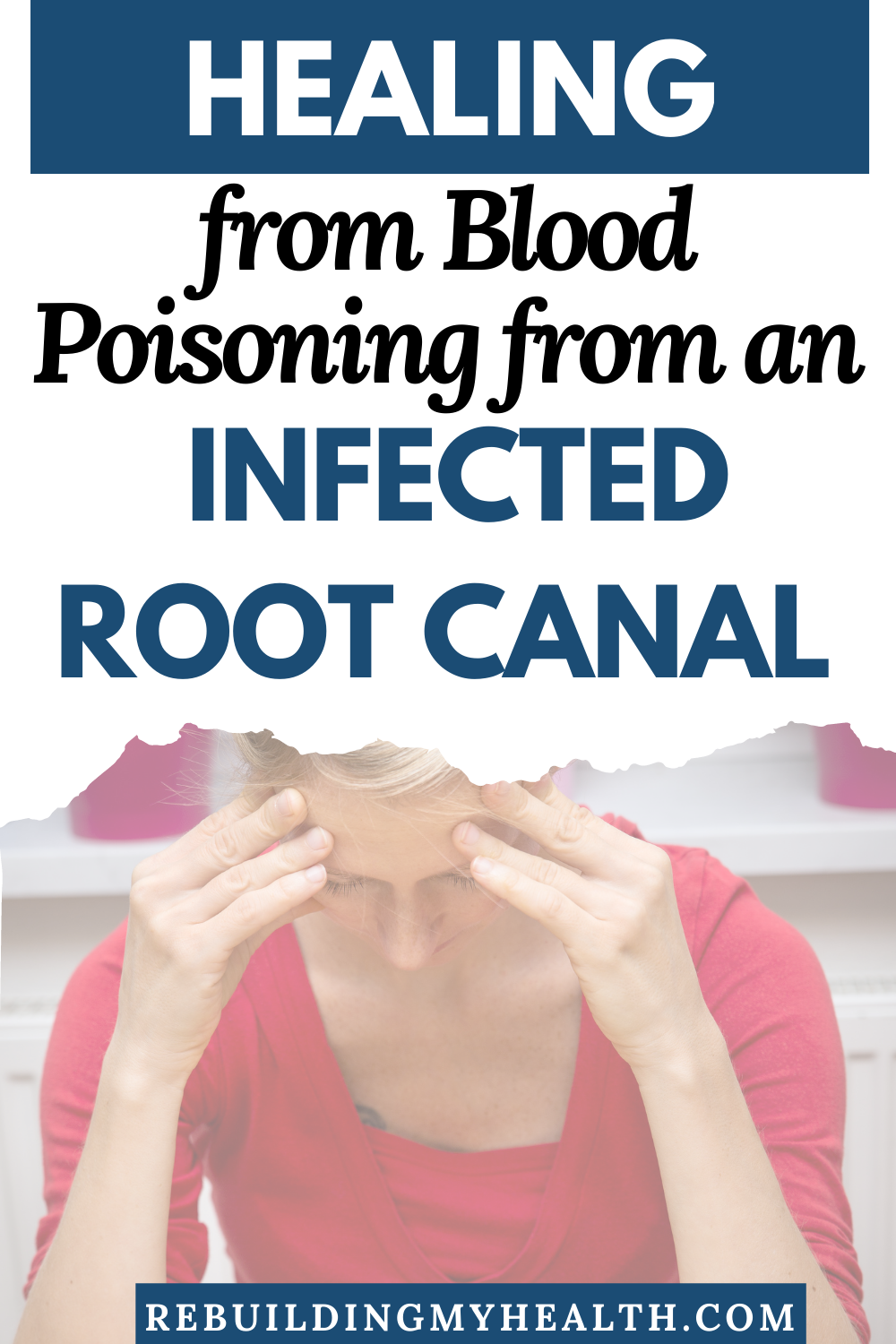How One Woman Healed from a Life-Threatening Infected Root Canal
“The surgeon told me I am so lucky to even be alive because typically blood infections travel up to your brain and mine traveled down. Who would ever in a million years associate a root canal with having pain in your right thigh? It was the most bizarre situation.”
– Krystal Norris
On New Year’s Eve 2017, Krystal Norris had planned a fun night out celebrating with her husband. But early in the evening, she found herself sidelined with vomiting and excruciating pain.
The pain and illness that had plagued her for nearly a year had escalated to unbearable levels. She had felt flu-like for much of the previous week and blinding pain traveled from her neck all the way down the right side of her body into her leg.
“The pain was worse than having two children without an epidural,” she recalls.
So instead of ringing in the New Year at a party, Krystal headed straight for the emergency room.
The Root Cause of Her Illness
Doctors quickly began asking questions and running tests. Soon, they found answers that had eluded Krystal for months.
“They said, ‘We have something important to tell you. You have blood poisoning.’ Then they asked, ‘Have you had any recent surgeries?’” Krystal recalls.
She replied that she had not. But as she rested and ruminated over their findings, it suddenly hit her.
“I sat up in the bed and said, ‘Oh my God, I had a root canal about seven or eight months ago and within two to three weeks I started having all these weird things happening to me.’”
Doctors immediately suspected the blood poisoning came from a root canal.
The Root Canal Controversy
Root canal procedures are typically performed when the pulp of a tooth becomes inflamed or infected. A dentist or endodontist removes the affected material and then cleans and seals the tooth again. The goal is to save the natural tooth.
These procedures are performed frequently, and many people have no known residual problems afterward.
The position of the American Association of Endodontists is thus: “It is in the best interest of patients to understand there is no valid, scientific evidence linking root canals to any health problems, and also to understand the advancements in modern dentistry that make endodontic treatment predictable, effective and successful.”
However, the procedure can lead to systemic health issues for some, like Krystal.
In a 2009 study, 5,000 extracted root-canal treated teeth were examined in a published peer-reviewed study and 100 percent were found to still have pathogens and toxins.
Instead of eliminating infection, the root canal sites became sites of infection in all studied cases. However, not everyone will experience symptoms.
Holistic or biological dentists may offer patients alternatives to traditional root canal procedures. Beyond removing the tooth altogether, some offer approaches that may reduce the potential for further infection within the tooth, such as laser therapy or ozone treatment.
Lucky to Be Alive
Prior to her root canal, Krystal’s tooth, with a crack going all the way down it, increased the likelihood of problems as bacteria could more easily settle in.
Fortunately, a dentist across the street from the hospital was available to perform an emergency removal of the tooth at 6 a.m. on New Year’s Day 2018. Meanwhile, doctors put her on antibiotics to address the infection immediately.
Krystal soon learned just how fortunate she was to find the problem.
“The surgeon told me I am so lucky to even be alive because typically blood infections travel up to your brain and mine traveled down,” she says. “Who would ever in a million years associate a root canal with having pain in your right thigh? It was the most bizarre situation.”
The infection explained the mysterious symptoms Krystal had endured for nearly a year. Within weeks of her root canal, she had started having migraines, neck pain, ear pain, pain running into her leg, sinus infections, loss of smell and hair loss. She also had recurring bladder and yeast infections.
Additionally, she had been diagnosed with bacteria in her cheek pocket, a rare occurrence.
The infections had mostly been in her face, but the pain extended into the entire right side of her body. She never connected it to the root canal because the tooth area itself NEVER hurt.
“The thing is, I had absolutely not an ounce of pain in my mouth, not anywhere near the root canal area or anywhere around the surrounding teeth,” she says.
A Carousel of Doctors
In the months leading up to that ER trip, Krystal had searched for answers. She spent thousands of dollars seeing her primary care doctor, an ear nose and throat specialist, neurologist, and a gynecologist for pelvic pain. With each, she received what felt like guesses.
One doctor blamed it on muscle strain. Another thought it was just the flu. Another blamed hormones. One recommended anti-depressants. And another chalked it up to getting older.
“That one pissed me off,” she says. “You literally think you’re going crazy because everybody’s looking at you telling you’re fine and you’re not fine.”
None of them ran the bloodwork that would have uncovered blood poisoning – until she arrived, desperate, in the emergency room.
Within 30 Days, No More Pain
Within two hours of having her tooth pulled early that New Year’s Day 2018, Krystal’s ear pain stopped and she was able to swallow without pain.
“Within two weeks, my back pain was completely gone,” she says.
Soon, she regained her sense of smell.
All that happened in the first 30 days.
As time went on, she noticed she no longer had the recurring sinus infections, and the bladder and yeast infections that had been a frequent part of the previous year. And her hair started growing normally again.
Today: Healthy Body, Healthy Mouth
Today, Krystal is back to being healthy, active and feeling like herself. She does, however, have a gap remaining where the tooth was extracted and a removable, partial denture, or “flipper,” while her gums heal.
When her gums have healed enough, she’ll have a permanent bridge installed. Since the infection, she now knows not to use the type of metal that was used in the root canal, and will now avoid it.
“I still have bone fragments popping up from my gums sometimes because the bone had deteriorated,” she says.
With her alarming experience, she and her family approach their health very differently now. They pay more attention to preventive dental health, in particular.
She brushes her teeth with clove oil, a natural antimicrobial, twice a week. She also takes drops of colloidal silver as a natural antibiotic.
She cleans her family’s toothbrushes with a mix of water and tea tree oil and buys only organic toothpaste.
“After all the oral hygiene I do, I have no issues with my gums or teeth anymore,” she says. “Before the root canal, I had teeth sensitivity and bleeding gums, which I don’t have anymore.”
The family was also inspired to change their diets by eliminating food dyes and processed food. They buy vegetables from local farms. And by switching her two sons to almond milk, their asthma has improved.
After her experience, Krystal warns others facing root canals.
“Don’t try to save your teeth,” she says. “You really are trying to save dead tissue in a dead tooth by doing a root canal.”
“They literally did the root canal and kept a fractured tooth and they do it all the time,” she says. “It is a regular practice in the dental industry. I look back and think, my kids could be motherless right now because of that one choice.”
She recommends getting second or even third opinions before making major dental decisions, and finding a dentist who will listen to your concerns and work with you.
“Look at the x-rays, educate yourself on what a healthy tooth is supposed to look like and do your research on what’s being put in your mouth. Empower yourself.”
If you liked this story, you might also enjoy: Michigan Woman Heals from Lyme Disease – Only After Treating Old Root Canal Infections.
The information on this site is for educational and inspirational purposes only and is not intended to replace the advice of qualified professionals. Keep in mind that what works for one person may not work for another. Always consult your healthcare practitioners before beginning new approaches or treatments. Some links on Rebuilding My Health may be affiliate links. This means that we may receive a commission - with no additional cost to you - if you make any purchases using those affiliate links. Rebuilding My Health is a participant in the Amazon Services LLC Associates Program. Learn more.



